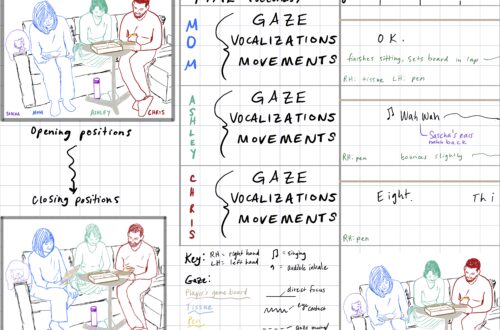Social Messages in “The Sound of Music”
New York University, 2019. Musical Theatre History.
Mother Abbess: “These walls were not made to shut out problems. You have to face them. You have to find the life you were born to live.” Maria: “How do I find it?” Mother Abbess: “Look for it. Climb every mountain… till you find your dream.”[1]
These words first inspired audiences 60 years ago, and their message of facing one’s problems and persisting against odds to pursue an authentic life has become universal – echoed in recent megahits like Frozen and Wicked, and substantiated by decades of research in the social and behavioral sciences that simply did not exist when they were penned. Additionally significant for its time, the advice was passed from one woman to another and unconventional for the era. With a book by Howard Lindsay and Russel Crouse and score by the incomparable team of Richard Rodgers and Oscar Hammerstein II (their final partnership before Hammerstein’s death[2]), The Sound of Music (herein SOM) is “the world’s most beloved musical” and the film adaptation “the most popular movie musical of all time.”[3] Indeed, SOM won six Tony Awards and five Oscars, including Best Musical and Best Picture (a distinction shared by only three other productions), the film ranks among the highest-grossing (adjusted for inflation), setting the record for longest first run in U.S. cinemas at four and a half years, and its original Broadway cast recording remained number one on the Billboard charts for 16 weeks.[4] While numerous aspects of this masterpiece merit discussion, this paper focuses on the social messages conveyed in the musical, referencing both the stage and screen versions (although there are some substantial differences, particularly concerning song selection and order, as well as arcs of certain secondary characters, the major themes are similar).
SOM addresses harsh realities of impending war and the emergence of one of the most infamous and devastating regimes in modern history through the lens of a relatable family. The creative team establishes a clear political stance through their depiction of the antagonists (the Nazi party, particularly as represented by Herr Zeller) and protagonists (particularly Captain von Trapp and Maria), who make choices to sacrifice status, comfort, security, and potentially their own and their children’s lives to stand up for what they believe is right. Despite urging by close friends, Captain von Trapp refuses to compromise his principles (one of the most blatant displays comes from the film, when he tears down the Nazi flag from his estate). An Austrian tourism site writes, “The family solidarity and the refusal of Baron von Trapp to obey the Nazis and enter the Wehrmacht are probably the strongest elements in The Sound of Music.”[5]
SOM does not overlook the complexities citizens faced when Hitler came to power. Several secondary characters audiences identify with and like promote the position taken by many from that era and locale – comply, ignore, and look out for one’s own self – and this more nuanced view of humanity is emphasized in the stage production. Max frequently makes assertions like the following: “Georg, why don’t you look at things the way I do? What’s going to happen is going to happen. Just be sure it doesn’t happen to you” (p. 49) and ingratiates himself with the powers that be, even if they are Nazis (e.g., he comments on his promotion from Third to First Secretary of the Ministry of Education and Culture following the Anschluss [p. 86]).
One of the most significant differences between the stage production and film is Elsa’s strong endorsement of Max’s view of compliance. In the original work, she and Max sing a duet about compromising and looking out for oneself – that’s their philosophy to get ahead in general and what they plan to do with the Nazis. The result of the views expressed in this scene is the rupture of the Captain and Elsa’s engagement (p. 76-79), making a stronger political statement than in the film, where the main cause of Elsa’s departure is perceived affection between the Captain and Maria.
Another difference worth noting between stage and screen is Rolf’s alliances. Though on stage he still sides with the Nazis, he does not betray the family in the climactic escape scene; rather, he finds the family but decides not to alert the Nazis. This act of love or compassion, as well as Max’s assistance in helping the family flee at the conclusion of the Kaltzberg Festival concert, furthers SOM’s gracious treatment of humanity: people who side with evil are still capable of good.
SOM also offers productive commentary on social norms like class and women’s roles. Though the Austrian nobility lost their official power in 1919, class distinctions persisted, and a baron such as von Trapp would have continued to hold a significant social position.[6] He initially courts the glamorous and socially suitable Elsa (in the film, she is a baroness; on stage, simply Frau Schraeder, an affluent but untitled widow – who also serves as president of the corporation formed to manage her late husband’s abundant assets [p. 44]). In contrast, Maria is an orphan (a particularly low caste in that era) and aspiring nun-turned-governess. As his employee, it would have been customary for someone of Captain von Trapp’s rank to dismiss Maria; yet he quickly begins to esteem her as an equal (long before making the bold choice to marry her). For example, when hosting the elegant soirée for the Austrian elite, the Captain prepares to invite Fräulein Maria to dine with the party – to which Max staunchly objects (though he is careful not to insult the Captain’s opinion of Maria, saying rather that the other guests would object [p. 59]). Anytime Max seeks to change Captain von Trapp’s opinion, he beseeches von Trapp’s significant other (Elsa, who assists; later Maria, who refuses [p. 89]) to explain or use her influence over him. Though this treatment may not have been revolutionary, it is significant in showing that men recognized the power women had over their husbands, even during a period when the man had the final say. Maria’s behavior is complex – from the opening of the show, her vibrant but untamed spirit bucks order and discipline, particularly when policies run contrary to her beliefs. Before they marry, she overtly contradicts and disobeys the Captain when they disagree; after marriage, she seems more willing to let him lead her and the family. Late in the musical, when Georg seeks her opinion on the crucial decision of choosing immediate safety for the family by serving in the Third Reich’s Navy or risking endangering them all by continuing to resist, Maria defaults to his authority and pledges obedience (p. 92). Though Maria’s character is still seen as independent overall, the wording of this scene clearly reflects the traditional views of the eras in which it was set and/or written.
Returning to the opening of this paper, what resonates most personally from SOM are the life lessons (beautifully articulated in the scenes between Maria and the Mother Abbess, as well as when Maria repeats the counsel to Liesl and the other children): you can’t run away from your problems – you must face your fears. Pursue the life that you want and are meant to live, even if that means a different path than you planned (an additional religious element I appreciate is the Mother Abbess’ poignant statement, “If you love this man [i.e., if you don’t become a nun], it doesn’t mean that you love God less” [p. 67]). When you try something that scares you, you may find exactly what you’re looking for. Seek help from others yet also trust yourself. Give people second chances. And my personal favorite: practice gratitude, which is memorably exemplified in the lyrics of “My Favorite Things,” including, “…when I’m feeling sad, I simply remember my favorite things, and then I don’t feel so bad.” When the children are despondent about Maria’s departure, Louisa reminds them, “When Fräulein Maria wanted to feel better, she used to sing that song – remember?” (p. 71).
From a contemporary perspective, these viewpoints sound commonplace – yet what I find most remarkable is that the creative team crafted messages related to wellbeing that have been substantiated by (now decades of) research in the social and behavioral sciences. SOM was written in a time when psychology focused on abnormalities and deficits; positive psychology did not receive widespread scholarly acceptance until 1998.[7] One of the pillars of positive psychology is that a practice of gratitude is extremely beneficial for wellbeing (both among “well-functioning” populations and those who experience depression and anxiety[8]) – and Rodgers and Hammerstein summed up this notion in a song simple enough for generations of children to understand and repeat.
No paper on SOM could be complete without highlighting its message of the beauty – and necessity – of having music in one’s life. The beneficial aspects of music and its potential applications for improved quality of life are detailed in copious research in music therapy;[9] what more fitting way to tell this particular story than in a musical? “Music is the all-encompassing element in The Sound of Music, a powerful and almost magical combination, which not only unites the Trapp family, but also underlines how the power of strength, togetherness and love, as well as a sense of community could be maintained even during the war period.”[10]
Though I don’t
mean to imply that SOM is perfect, it
certainly excels in presenting many carefully informed prosocial messages in an
unparalleled way. The ability of the arts to reflect as well as shape culture
is extraordinary – and the phenomenal reach and long-lasting popularity of SOM set it apart from many other
exquisite works in terms of influence. Additional to its captivating story and
brilliant songs, SOM appeals and
endures because of the still-relevant life lessons it teaches and way it
dramatizes an intriguing period of history from a less-common perspective
(family life versus a battlefield or concentration camp) and its basis in
reality (even if considerable liberty was taken in the representation of the
von Trapp family). By presenting such themes in a relatable and enjoyable way
that is also appropriate for young audiences, an essential part of world
history is preserved and inspiring lessons taught in a palatable way for people
who might never pick up a book on Nazism, watch a WWII documentary, or read psychology
literature. Further, this wholesome family favorite is able to achieve so much
precisely because it is a musical; its prosocial messages are conveyed through
memorable songs whose lyrics will be repeated and stick with the viewer
throughout their life. Having masterfully captured this work on film extends
the reach of SOM exponentially (SOM is my favorite musical, and I’ve
only seen it live on stage twice – yet I had the movie practically memorized
before age 6). Reviewer Noo Saro-Wiwa writes, “That’s the genius of the film:
it wears its social commentary lightly. Don’t be fooled by the sing-along
frivolity – the narrative is packed with edgy, progressive and humorous
themes.”[11]
SOM has shaped my life as a person
and performer in profound ways – and its timeless appeal promises to continue
to do so for generations.
[1] The Sound of Music Libretto. Copyright 1960. Richard Rodgers, Oscar Hammerstein II, Howard Lindsay, and Russel Crouse. P. 67. This version is referenced throughout.
[2] Kenrick, John. Musical Theatre: A History. New York: Bloomsbury, 2017. 201-202.
[3] The Rodgers and Hammerstein Organization.
[4] Wilson, Gemma. “Let’s Start at the Very Beginning! 50 Fun Facts About The Sound of Music on the Film’s 50th Anniversary.” Facts 18, 20, 41, 42.
[5] The Background and How the Sound of Music Became So Popular.
[6] Wikipedia: Austrian Nobility.
[7] Seph Fontane Pennock, “The 5 Founding Fathers and A History of Positive Psychology.”
[8] Joel Wong and Joshua Brown, “How Gratitude Changes You and Your Brain.”
[9] For example, in treating pain, mental illness, and neurologic conditions, as well as bridging the gap for patients who are resistant to traditional psychotherapy (I particularly admire work by Diane Austin, John Mondanaro, Amy M. Donnenwerth, and Laurien Hakvoort, to name a few).
[10] The Background and How the Sound of Music Became So Popular.
[11] Noo Saro-Wiwa, “Why The Sound of Music is still genius at 50.”




One Comment
Pingback: